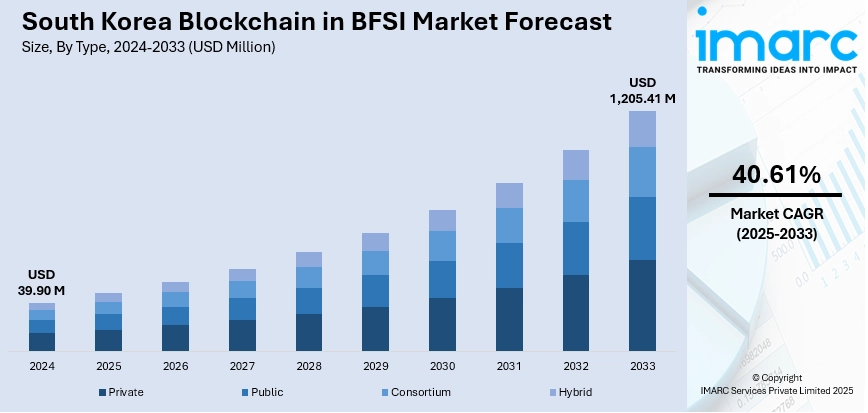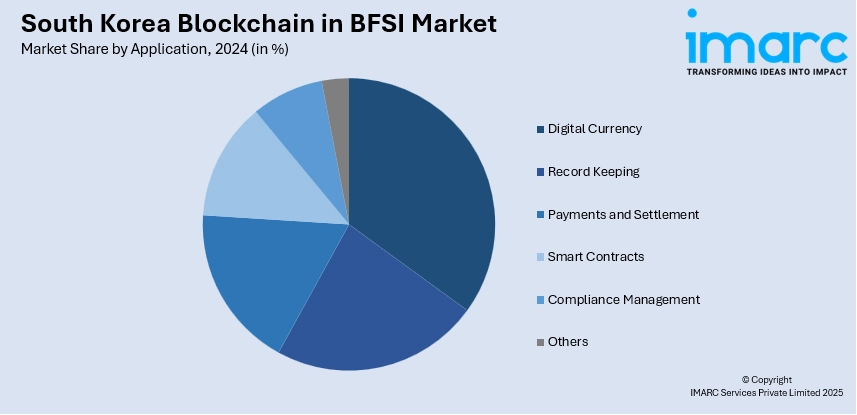
South Korea Blockchain in BFSI Market Size, Share, Trends and Forecast by Type, Component, Application, End User, and Region, 2025-2033
South Korea Blockchain in BFSI Market Overview:
The South Korea blockchain in BFSI market size reached USD 39.90 Million in 2024. Looking forward, IMARC Group expects the market to reach USD 1,205.41 Million by 2033, exhibiting a growth rate (CAGR) of 40.61% during 2025-2033. Increasing demand for secure digital transactions, regulatory support, rapid fintech growth, focus on fraud prevention, operational efficiency, and rising investments in blockchain R&D by banks, insurers, and asset management firms are some of the factors contributing to South Korea blockchain in BFSI market share.
|
Report Attribute
|
Key Statistics
|
|---|---|
|
Base Year
|
2024
|
|
Forecast Years
|
2025-2033
|
|
Historical Years
|
2019-2024
|
| Market Size in 2024 | USD 39.90 Million |
| Market Forecast in 2033 | USD 1,205.41 Million |
| Market Growth Rate 2025-2033 | 40.61% |
South Korea Blockchain in BFSI Market Trends:
Digital Assets Redefining Finance
In South Korea, digital currencies are now more widely used than traditional investment tools. Interest in blockchain-powered financial services is expanding rapidly, with crypto platforms evolving beyond simple trading to offer full financial functionality. This shift is prompting upgrades in payment systems, lending models, asset custody, and AI-enabled trading. As blockchain becomes more embedded in daily financial activity, expectations around speed, transparency, and security are rising. Traditional financial institutions are responding by exploring partnerships, infrastructure improvements, and new service layers to stay competitive. The broader financial landscape is now shaped by this growing reliance on decentralized tools, reflecting a cultural and economic turn toward new digital norms in banking, insurance, and investment services. These factors are intensifying the South Korea blockchain in BFSI market growth. For example, as of March 2025, South Korea now has over 16 million cryptocurrency users, overtaking stock investors and marking a major shift in the country’s BFSI landscape. This surge, backed by platforms like Upbit and Bithumb, shows 32% of the population engaging with blockchain-powered fintech services. As crypto exchanges evolve into full-service financial platforms, demand is rising for secure, scalable blockchain infrastructure, pushing innovation across payments, lending, custody, and AI-driven trading tools in the region.

To get more information on this market, Request Sample
Tighter Blockchain Oversight in Financial Services
In South Korea, blockchain regulation is entering a new phase with stricter enforcement targeting digital assets. Authorities are beginning to integrate blockchain data with legal and financial records to identify individuals evading taxes through crypto holdings. The approach marks a broader push toward transparency and accountability in how digital assets are managed across financial and insurance services. As blockchain tools become more embedded in financial systems, regulatory bodies are responding with more sophisticated monitoring and asset control measures. The focus is shifting from passive reporting to active enforcement, encouraging compliance among individuals and institutions. This signals a deeper alignment between blockchain operations and traditional regulatory frameworks within the country’s financial infrastructure. For instance, in March 2025, Gwacheon city in South Korea launched a digital asset seizure system to target crypto-related tax evasion. Authorities would match exchange data with criminal records to identify offenders. Initially focusing on 361 individuals, the system would notify them to pay outstanding taxes or face confiscation of their crypto assets. The move signals a tightening of blockchain oversight within the BFSI sector as enforcement expands in the coming months.
South Korea Blockchain in BFSI Market Segmentation:
IMARC Group provides an analysis of the key trends in each segment of the market, along with forecasts at the country and regional levels for 2025-2033. Our report has categorized the market based on type, component, application, and end user.
Type Insights:
- Private
- Public
- Consortium
- Hybrid
The report has provided a detailed breakup and analysis of the market based on the type. This includes private, public, consortium, and hybrid.
Component Insights:
- Platform
- Services
The report has provided a detailed breakup and analysis of the market based on the component. This includes platform and services.
Application Insights:

- Digital Currency
- Record Keeping
- Payments and Settlement
- Smart Contracts
- Compliance Management
- Others
The report has provided a detailed breakup and analysis of the market based on the application. This includes digital currency, record keeping, payments and settlement, smart contracts, compliance management, and others.
End User Insights:
- Banking
- Insurance
- Non-Banking Financial Companies (NBFCs)
A detailed breakup and analysis of the market based on the end user have also been provided in the report. This includes banking, insurance, and non-banking financial companies (NBFCs).
Regional Insights:
- Seoul Capital Area
- Yeongnam (Southeastern Region)
- Honam (Southwestern Region)
- Hoseo (Central Region)
- Others
The report has also provided a comprehensive analysis of all the major regional markets, which include Seoul Capital Area, Yeongnam (Southeastern Region), Honam (Southwestern Region), Hoseo (Central Region), and others.
Competitive Landscape:
The market research report has also provided a comprehensive analysis of the competitive landscape. Competitive analysis such as market structure, key player positioning, top winning strategies, competitive dashboard, and company evaluation quadrant has been covered in the report. Also, detailed profiles of all major companies have been provided.
South Korea Blockchain in BFSI Market News:
- In July 2025, South Korea’s Ministry of SMEs and Startups proposed amending existing law to let crypto firms register as “venture companies,” making them eligible for benefits like tax cuts. Currently excluded alongside gambling businesses, crypto trading and brokerage firms could soon qualify for official venture certification. This shift would offer government-backed advantages to digital asset companies, aligning them with other tech-focused startups based on investment, R&D, or tech evaluation.
South Korea Blockchain in BFSI Market Report Coverage:
| Report Features | Details |
|---|---|
| Base Year of the Analysis | 2024 |
| Historical Period | 2019-2024 |
| Forecast Period | 2025-2033 |
| Units | Million USD |
| Scope of the Report |
Exploration of Historical Trends and Market Outlook, Industry Catalysts and Challenges, Segment-Wise Historical and Future Market Assessment:
|
| Types Covered | Private, Public, Consortium, Hybrid |
| Components Covered | Platform, Services |
| Applications Covered | Digital Currency, Record Keeping, Payments and Settlement, Smart Contracts, Compliance Management, Others |
| End Users Covered | Banking, Insurance, Non-Banking Financial Companies (NBFCs) |
| Regions Covered | Seoul Capital Area, Yeongnam (Southeastern Region), Honam (Southwestern Region), Hoseo (Central Region), Others |
| Customization Scope | 10% Free Customization |
| Post-Sale Analyst Support | 10-12 Weeks |
| Delivery Format | PDF and Excel through Email (We can also provide the editable version of the report in PPT/Word format on special request) |
Key Questions Answered in This Report:
- How has the South Korea blockchain in BFSI market performed so far and how will it perform in the coming years?
- What is the breakup of the South Korea blockchain in BFSI market on the basis of type?
- What is the breakup of the South Korea blockchain in BFSI market on the basis of component?
- What is the breakup of the South Korea blockchain in BFSI market on the basis of application?
- What is the breakup of the South Korea blockchain in BFSI market on the basis of end user?
- What is the breakup of the South Korea blockchain in BFSI market on the basis of region?
- What are the various stages in the value chain of the South Korea blockchain in BFSI market?
- What are the key driving factors and challenges in the South Korea blockchain in BFSI market?
- What is the structure of the South Korea blockchain in BFSI market and who are the key players?
- What is the degree of competition in the South Korea blockchain in BFSI market?
Key Benefits for Stakeholders:
- IMARC’s industry report offers a comprehensive quantitative analysis of various market segments, historical and current market trends, market forecasts, and dynamics of the South Korea blockchain in BFSI market from 2019-2033.
- The research report provides the latest information on the market drivers, challenges, and opportunities in the South Korea blockchain in BFSI market.
- Porter's five forces analysis assist stakeholders in assessing the impact of new entrants, competitive rivalry, supplier power, buyer power, and the threat of substitution. It helps stakeholders to analyze the level of competition within the South Korea blockchain in BFSI industry and its attractiveness.
- Competitive landscape allows stakeholders to understand their competitive environment and provides an insight into the current positions of key players in the market.
Need more help?
- Speak to our experienced analysts for insights on the current market scenarios.
- Include additional segments and countries to customize the report as per your requirement.
- Gain an unparalleled competitive advantage in your domain by understanding how to utilize the report and positively impacting your operations and revenue.
- For further assistance, please connect with our analysts.
 Request Customization
Request Customization
 Speak to an Analyst
Speak to an Analyst
 Request Brochure
Request Brochure
 Inquire Before Buying
Inquire Before Buying




.webp)




.webp)












